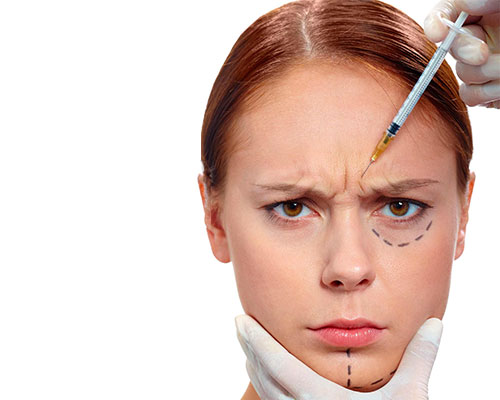Understanding and Treating Glabellar Lines: A Comprehensive Guide
Glabellar lines, those subtle or not-so-subtle wrinkles between the eyebrows, can often be a concern for many individuals. These lines, also known as frown lines or “11” lines, tend to become more noticeable as we age and can impact our overall facial appearance. In this comprehensive guide, we’ll delve into the causes of glabellar lines, explore effective treatments, and discuss proactive measures to prevent their formation.

Causes of Glabellar Lines
Glabellar lines aren’t just a sign of aging; they can also result from repeated facial expressions. The muscles between the eyebrows contract when we frown, and over time, these contractions contribute to the development of lines. Sun exposure and ultraviolet (UV) damage also play a role, as UV rays accelerate collagen and elastin breakdown, leading to decreased skin elasticity. Additionally, the loss of collagen and hyaluronic acid as we age contributes to the formation of these lines.
Symptoms and Visibility
Glabellar lines typically appear as vertical wrinkles that run between the eyebrows. They become more evident when we frown, furrow our brows, or make certain facial expressions. These lines can give a person an unintentionally angry or stern appearance, impacting how they are perceived by others. As a result, many individuals seek ways to address or prevent the visibility of glabellar lines.
Prevention Strategies
Preventing glabellar lines starts with practicing good sun protection and skincare habits. Applying sunscreen daily, even on cloudy days, helps shield your skin from harmful UV rays. Incorporating antioxidants into your skincare routine can combat free radical damage, which contributes to premature aging. Facial exercises and relaxation techniques can also be beneficial, as reducing unnecessary muscle tension can help prevent lines from deepening
Non-Surgical Treatment Options
Botox Injections
Botox, a well-known option for glabellar line treatment, works by temporarily paralyzing the muscles responsible for frowning. This reduces muscle contractions, leading to smoother skin and diminished lines. The procedure is quick and minimally invasive, with results lasting several months.
Dermal Fillers
Dermal fillers, such as hyaluronic acid-based products, can add volume and plumpness to the skin, reducing the appearance of glabellar lines. These fillers help fill in wrinkles and creases, providing a natural-looking rejuvenation effect. Results vary, but they typically last around 6 to 12 months.
Minimally Invasive Procedures
Microdermabrasion
Microdermabrasion exfoliates the skin’s outer layer, encouraging cell turnover and collagen production. Over time, this can help improve the texture of the skin and minimize the visibility of glabellar lines. It’s a gentle procedure with little to no downtime.
Chemical Peels
Chemical peels involve applying a chemical solution to the skin, causing controlled exfoliation and peeling. This stimulates the growth of new skin cells and collagen, resulting in smoother and more youthful skin. Different types of peels are available, ranging from mild to deep, depending on the severity of the lines.
Advanced Treatments
Laser Therapy
Laser treatments, such as fractional laser therapy, can target the deeper layers of skin to stimulate collagen production. This helps reduce the appearance of glabellar lines and improve overall skin texture. Laser therapy requires multiple sessions and downtime for recovery.
Radiofrequency Treatments
Radiofrequency (RF) treatments use heat energy to tighten the skin and stimulate collagen production. RF devices can be used to treat glabellar lines, promoting a more youthful appearance. These treatments are generally comfortable and require minimal downtime.
Ultrasound Therapy
Ultrasound therapy delivers focused ultrasound energy deep into the skin, triggering collagen production. This helps tighten and lift the skin, reducing the visibility of lines. Results develop gradually over a few months.
Consulting a Dermatologist
While exploring treatment options is essential, consulting a dermatologist is crucial before making any decisions. A dermatologist can assess your skin’s condition, discuss your goals, and recommend the most suitable treatment plan. They will consider factors such as your skin type, medical history, and desired outcomes to ensure safe and effective results.
FAQs About Glabellar Lines
Q: What are glabellar lines?
A: Glabellar lines, often called frown lines or “11” lines, are wrinkles that form between the eyebrows due to muscle contractions and aging.
Q: Can younger individuals develop glabellar lines?
A: Yes, even younger people can develop glabellar lines from repeated facial expressions and sun exposure over time.
Q: Are glabellar lines preventable?
A: Yes, practicing sun protection, using skincare with antioxidants, and adopting facial relaxation techniques can help prevent their formation.
Q: What causes glabellar lines to deepen?
A: Repeated muscle movements and collagen loss due to aging can cause glabellar lines to become more pronounced over time.
Q: Do genetics play a role in glabellar lines?
A: Genetics can influence how prone you are to developing glabellar lines, but lifestyle factors also contribute.
Q: Can I treat glabellar lines at home with creams?
A: While creams may help improve skin texture, professional treatments like Botox and dermal fillers offer more noticeable results.
Q: How long do the effects of Botox last for glabellar lines?
A: Botox results typically last around 3 to 4 months before a touch-up is needed.
Q: Are there risks associated with non-surgical treatments?
A: Non-surgical treatments like Botox and fillers are generally safe when administered by a qualified professional.
Q: Can glabellar lines be permanently removed?
A: While treatments can provide long-lasting results, glabellar lines may reappear over time due to natural aging and facial expressions.
Q: Is a consultation with a dermatologist necessary for treatment?
A: Yes, consulting a dermatologist ensures you receive personalized recommendations and safe, effective treatment options.
Conclusion
Addressing glabellar lines requires a comprehensive approach that combines preventive measures and professional treatments. Whether you opt for non-surgical options, minimally invasive procedures, or advanced therapies, working with a knowledgeable dermatologist ensures that you receive personalized care tailored to your unique needs. Embrace the journey towards a smoother, more youthful appearance and take the first step towards boosting your confidence and self-esteem.




